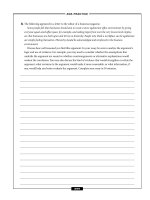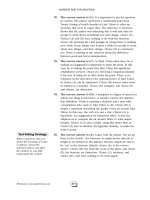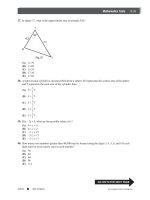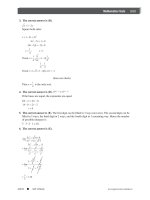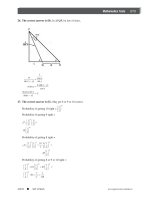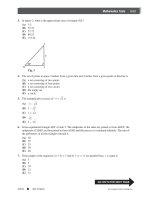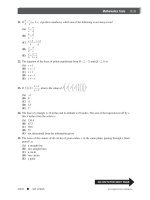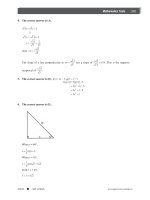SAT II Biology Episode 2 Part 6 pot
Bạn đang xem bản rút gọn của tài liệu. Xem và tải ngay bản đầy đủ của tài liệu tại đây (193.13 KB, 20 trang )
6. Which of the following is true for freshwa-
ter ecosystems?
(A) I. There is a seasonal mixing of
materials.
(B) II. During the year, oxygen
concentrations are vertically
uniform.
(C) III. Materials are recycled more
quickly than in ocean ecosys-
tems.
(A) I only
(B) II only
(C) III only
(D) I and III are both true.
(E) II and III are both true.
7. Midlatitude lakes undergo mixing more than
equatorial lakes because
(A) the midlatitude lakes turn over twice a
year.
(B) midlatitude lakes develop a ther-
mocline.
(C) water is densest at 4
o
C.
(D) all of the above.
(E) they don’t—equatorial lakes have more
mixing.
8. Which of the following statements about
eutrophication is NOT true?
(A) It is caused by acid rain.
(B) It is caused by the addition of nutrients
to a water system.
(C) It is most harmful when there is little
flow through in the system.
(D) Phosphorus is the main causal agent.
(E) Humans are responsible for most
eutrophication.
9. Which of the following statements about
acid rain is true?
(A) I. Acid rain is caused by nitric
acid and sulfuric acid.
(B) II. Acid rain can damage plants
directly.
(C) III. Acid rain can cause magnesium
and calcium to be leached from
the soil.
(A) I only
(B) II only
(C) III only
(D) II and III are both true.
(E) I, II, and III are all true.
10. Which of the following statements about
the carbon cycle is NOT true?
(A) Carbon dioxide levels fluctuate during
the year.
(B) Carbon dioxide levels are rising
because of consumption of fossil fuels.
(C) Atmospheric carbon dioxide will
eventually be transferred to the oceans.
(D) Carbon dioxide levels are up because of
the burning of forests.
(E) Carbon dioxide levels can be reduced
by cleaning the gases that leave the
smokestacks of power generating
facilities.
➡
GO ON TO THE NEXT PAGE
PRACTICE TEST 2
TEST 2—Continued
277
Peterson’s n SAT II
Success: Biology E/M www.petersons.com
11. Consider the following diagram,
illustrative of the species richness
equilibrium.
1. Circle number 3 represents the equilibrium
of
(A) a small island far from the mainland.
(B) a small island close to the mainland.
(C) a large island far from the mainland.
(D) a large island close to the mainland.
(E) the natality and mortality rates on any
island.
2. A fungus living on a dead tree is a
(A) saprophyte.
(B) heterotroph.
(C) consumer.
(D) all of the above.
(E) none of the above.
1. Questions 77–79 refer to the diagram
below, which shows the general
location of some major biomes of the
Western Hemisphere.
2. The most stable biome is represented by
letter
(A) A.
(B) B.
(C) C.
(D) D.
(E) E.
3. Which type of biome is indicated by letter
E?
(A) tundra
(B) taiga
(C) grassland
(D) deciduous forest
(E) chaparral
PRACTICE TEST 2
TEST 2—Continued
278
Peterson’s n SAT II
Success: Biology E/Mwww.petersons.com
4. The biome indicated by letter F is character-
ized by
(A) heavy rainfall, broad-leaved plants, and
monkeys.
(B) sparse rainfall, grasses, and leopards.
(C) variable rainfall, mosses, and caribou.
(D) heavy rainfall, conifers, and snakes.
(E) variable rainfall, moderate temperatures,
and low humidity.
5. The return of salmon to their own birth-
place to breed is an example of
(A) habituation.
(B) a stimulus.
(C) operant conditioning.
(D) reasoned behavior.
(E) imprinting.
1.
If you answered the first 80 questions STOP HERE.
If you are taking the Biology-M test CONTINUE HERE.
PRACTICE TEST 2
TEST 2—Continued
279
Peterson’s n SAT II
Success: Biology E/M www.petersons.com
BIOLOGY-M TEST
Directions: Each of the questions or statements below is accompanied by five choices. For each
question, select the best of the answer choices given.
2. Alfred Hershey and Martha Chase performed
a famous experiment that has been dubbed
the “blender experiment.” In it, they
attempted to prove that the hereditary
material was DNA. It is named the blender
experiment because
(A) I. they blended viruses and
bacteria into agar slants.
(B) II. they blended bacteria and
viruses together after infection
to rid the bacteria of their virus
coats.
(C) III. they found that by blending
viruses and bacteria together,
the viruses could be trapped on
the sides of the blender.
(A) I only
(B) II only
(C) III only
(D) II and III are both true.
(E) I, II, and III are all true.
3. Which of the following statements about
the “blender experiment” is NOT true?
(A) The experiment preceded Watson’s and
Crick’s elucidation of DNA structure.
(B) Hershey and Chase used radioactive
sulfur to follow the protein in their
experiment.
(C) Hershey and Chase used radioactive
phosphorus to follow the nucleotides in
their experiment.
(D) It was discovered by them that while
different strains of bacteria have
different percentages of nitrogen bases,
the percent of adenine and the percent
of thymine are equal, as are the
percents of guanine and cytosine.
(E) Hershey and Chase’s experiment lent
strong credence to the idea that DNA is
the hereditary material, at least for
viruses.
4. The number of base pairs in a typical
bacterium is about __________, while the
number in human cells is around
__________.
(A) 3 million, 3 billion
(B) 1 million, 1 billion
(C) 3,000, 3 million
(D) 1,000, 1 million
(E) 1 billion, 12 trillion
PRACTICE TEST 2
TEST 2—Continued
280
Peterson’s n SAT II
Success: Biology E/Mwww.petersons.com
5. The proteins around which human DNA is
wound are
(A) cyclins.
(B) cyclin-dependent kinases.
(C) histones.
(D) heat-shock proteins.
(E) G proteins.
6. The proteins that come together to form
“maturation promoting factors,” or “M
phase factors,” are
(A) cyclins.
(B) cyclin-dependent kinases.
(C) G proteins.
(D) cyclins and cyclin-dependent kinases.
(E) cyclin-dependent kinases and G
proteins.
7. Restriction enzymes were originally isolated
from
(A) viruses, which use them to cut bacterial
DNA.
(B) bacteria, which use them to cut viral
DNA.
(C) viruses, which use them to turn off
their host bacterial DNA.
(D) protists, which use them to organize
themselves into colonial life-forms.
(E) injured tissue, where they restrict the
movement of molecules across the
plasma membrane.
8. If a restriction enzyme has as its recognition
sequence “ATCCTA,” how many restriction
sites would appear in the lambda genome,
which is approximately 54,000 bp?
(A) 13
(B) 9,000
(C) 2,250
(D) 7
(E) 10,000
➡
GO ON TO THE NEXT PAGE
PRACTICE TEST 2
TEST 2—Continued
281
Peterson’s n SAT II
Success: Biology E/M www.petersons.com
1. Questions 88–90 refer to the following
infor mation about genetic engineering.
1. Bacterial plasmid sequence: ATCCCA 1000
more nucleotides ATTAAGGCCTTACAG
GACCCCGGAATGAGAGTA ATGGGCTAT-
TCAGGTA 2000 more nucleotides
Human DNA sequence: ATATCGTAATGT-
TGGTG 500 more nucleotides GTGT-
CAGGACGGGTGAAAGCCAGGACGC-
CGAATCG 5000 more nucleotides
The underlined DNA signifies the gene of
interest we’re trying to clone
Restriction enzyme sequences:
ERA I
CRO I
MEM II
GTAATG
CAGGAC
GCCG
2. How many restriction sites appear in the
bacterial plasmid sequence?
(A) none
(B) 1
(C) 2
(D) 3
(E) more than 3
3. Which enzyme(s) should be used to insert
the human sequence into the plasmid?
(A) ERA I
(B) CRO I
(C) MEM II
(D) CRO I and ERA I
(E) ERA I, CRO I, and MEM II
4. How many bands would show up on a 1
percent agarose gel if the plasmid was cut
with both ERA I and CRO I?
(A) 1
(B) 2
(C) 3
(D) 100
(E) 1,000
5. A gene that is 1,500 nucleotides long codes
for a metabolic protein that is composed of
400 amino acids. The number of nucle-
otides in exons are ____________ and the
number of nucleotides in introns are
____________.
(A) 1,200; 300
(B) 300; 1,200
(C) 1,500; 0
(D) 0; 1,500
(E) 400; 1,100
6. Which of the following statement(s) about
RNA polymerases is (are) true?
(A) I. pry the two strands of DNA
apart
(B) II. add RNA nucleotides together
(C) III. bind to promoter regions of the
DNA to begin transcription
(A) I only
(B) II only
(C) III only
(D) II and III are both true.
(E) All of the above are true.
PRACTICE TEST 2
TEST 2—Continued
282
Peterson’s n SAT II
Success: Biology E/Mwww.petersons.com
7. Which of the following statements about
the lac operon is NOT true?
(A) RNA polymerase can be blocked by an
active repressor protein attached to the
operator.
(B) RNA polymerase attaches at a site on
the DNA strand, known as the pro-
moter.
(C) There is a regulatory gene that is
downstream from the structural genes
that can inhibit transcription.
(D) The regulatory gene produces the
active repressor.
(E) The repressor protein can be activated
by a substance like lactose, called the
inducer.
8. Which of the following statements about
the HIV virus is NOT true?
(A) The viral nucleotides contain ribose.
(B) HIV contains uracil, not thymine.
(C) HIV infection begins with the entrance
of the virus into the host when the gp
120 and gp 41 function to pull the
virus across the plasma membrane.
(D) HIV makes the host cell produce
reverse transcriptase.
(E) Immunization against HIV has proven
difficult because the virus mutates so
rapidly.
9. All of the following are means of post-
transcriptional control in eukaryotes
EXCEPT
(A) the capping of the 58 end with a
modified guanosine triphosphate.
(B) the addition of a poly-A tail to the 38
end.
(C) the cutting out of introns by a spliceo-
some.
(D) the ligation of exons by DNA poly-
merase.
(E) the attachment of signal sequences for
direction to specific destinations.
10. Which of the following statements is NOT
true concerning restriction fragment length
polymorphisms (RFLPs)?
(A) Suspects whose fragments do not
match any other fragments at a crime
scene can be vindicated.
(B) The polymerase chain reaction can be
used to produce more copies of DNA
obtained at a crime scene before RFLP
analysis.
(C) Most RFLPs use radioactive probes.
(D) Most RFLPs occur because of the
repetitive nature of DNA.
(E) With the advent of PCR technology,
restriction enzymes are no longer
needed to perform RFLP analysis.
➡
GO ON TO THE NEXT PAGE
PRACTICE TEST 2
TEST 2—Continued
283
Peterson’s n SAT II
Success: Biology E/M www.petersons.com
1. Questions 97–100 refer to the following
diagram.
2. Consider the following DNA nucleotides,
where A, C, G, and T represent adenine,
cytosine, guanine, and thymine:
TAC TTT TTG CTC ATC
The mRNA that would be transcribed from
that would be
(A) TUC TTT TTG CTC ATC.
(B) CGT CCC CCA TCT GCT.
(C) ATG AAA AAC GAG TAG.
(D) AUG AAA AAC GAG UAG.
(E) CGU CCC CCA UCU GCU.
3. The amino acids coded for are, in order,
(A) tyrosine, phenylalanine, leucine,
leucine, isoleucine.
(B) histidine, phenylalanine, valine, leucine,
leucine.
(C) leucine, phenylalanine, methionine,
leucine, stop.
(D) arginine, proline, proline, serine,
alanine.
(E) methionine, lysine, asparagine, glutamic
acid, stop.
4. Below is a list of the DNA coding sequence
for a metabolic enzyme. Which of the four
is most closely related to the first?
TAC TTT TTG CTC ATC
(A) ATC TTT TTG CTC ATC
(B) TAC TTC TTA CTT ATC
(C) TAC TTC TTG CTG ATC
(D) TAC TTC TAG CTC ATC
(E) Not enough information is given.
5. The number of tRNA molecules required by
eukaryotic organisms to ferry around the
amino acids is
(A) 64.
(B) 63.
(C) 45.
(D) 23.
(E) 20
STOP
If you finish before the hour is up, you may review your work on this test only. You may not turn to
any other test in this book.
PRACTICE TEST 2
TEST 2—Continued
284
Peterson’s n SAT II
Success: Biology E/Mwww.petersons.com
ANSWERS AND EXPLANATIONS
QUICK-SCORE ANSWERS
1. C
2. E
3. A
4. B
5. A
6. A
7. B
8. C
9. B
10. B
11. D
12. D
13. C
14. D
15. A
16. E
17. D
18. B
19. C
20. C
21. C
22. A
23. D
24. B
25. D
26. B
27. D
28. C
29. A
30. D
31. A
32. D
33. A
34. E
35. B
36. A
37. D
38. C
39. A
40. A
41. E
42. D
43. B
44. D
45. C
46. A
47. D
48. A
49. C
50. D
51. B
52. E
53. D
54. D
55. B
56. D
57. D
58. D
59. D
60. D
61. D
62. A
63. B
64. A
65. B
66. B
67. E
68. B
69. E
70. D
71. C
72. A
73. E
74. E
75. B
76. D
77. C
78. D
79. A
80. E
81. B
82. D
83. A
84. C
85. D
86. B
87. A
88. C
89. A
90. A
91. A
92. E
93. C
94. D
95. D
96. E
97. D
98. E
99. B
100. C
1. The correct answer is (C). The theory of acquired characteris-
tics, proposed by Lamarck, plays no part in the theory of natural
selection. It is not an accepted theory in biology.
2. The correct answer is (E). pH is defined as the negative log of
the hydrogen ion concentration. Therefore, the negative log,
choice (A), is 4. The pH and the pOH always add up to 14. And
since it is a logarithmic scale, the difference in concentration
between 4 and 7 is 1,000 times as strong.
3. The correct answer is (A). While the other interactions are
important, they give rise to tertiary structure.
4. The correct answer is (B). The water molecules will move
from a greater to a lesser concentration. The potato is hypertonic
to the water because it has a greater solute concentration.
Plasmolysis is the loss of water.
5. The correct answer is (A). Review the endomembrane system,
which is responsible for packaging molecules for transport. The
SER comes before the RER, and the golgi apparatus usually
attaches a carbohydrate or modifies the protein in some manner.
6. The correct answer is (A). The field of view is 4 mm at 40
magnifications (ocular lens × objective lens gives total magnifica-
tion). If he went to 400 magnifications, he would be looking at
1
⁄
10
as much, or 0.4mm. If 12 cells line up and cover 0.4mm, then
by division we get 0.033mm/cell.
7. The correct answer is (B). When doing dihybrid genetics
problems, think about the traits as a monohybrid cross. The only
way to have half gray and half black is hybrid × homozygous
285
Peterson’s n SAT II
Success: Biology E/M www.petersons.com
recessive. Since the first fly is gray, he must be Gg. The second
fly must be hybrid for wing length.
8. The correct answer is (C). The short-winged, green-eyed fly is
llrr, and the other parent is LlRr. Being hybrid for both traits is
necessary to produce the offspring that are non-parental types
and are the result of crossing over during meiosis.
9. The correct answer is (B). The question relates to question 8
and the recombinants produced by the LlRr fly. The diagram
below shows the results of crossing over that produced the
short-winged, green-eyed flies and the long-winged, red-eyed flies.
lL
Rr
10. The correct answer is (B). One of the major differences
between prokaryotes and eukaryotes is the presence of plasmids.
11. The correct answer is (D). Choices (A) and (C) are incorrect
because there are larger bands present than the original plasmid.
While the same size plasmids can travel at different rates based
on their conformation (relaxed, coiled, or supercoiled), there is
no reason to believe one would not see the band shown in lanes
2 and 3 in lane 1.
12. The correct answer is (D). Gel electrophoresis draws nega-
tively charged DNA to the positive pole. The smaller molecules
will migrate faster through the gel.
13. The correct answer is (C). The mother is a carrier, and the
father is colorblind. Their genotypes could be represented as
X
C
X
c
and X
c
Y.
14. The correct answer is (D). 2
4
is 16, AaBb could make 4, or
CcDd could make 4, so by multiplication, the probability of both
events is the product of their individual probabilities.
15. The correct answer is (A). Meiosis I results in two cells, but
there is no chromosome reduction at this point. During inter-
phase, the DNA had been synthesized, doubling the amount of
chromosomes. When divided into two cells, the number is 2N.
16. The correct answer is (E). Mitochondria are membrane-bound
organelles and, as such, exist in all eukaryotic cells but not in
prokaryotic (bacteria) cells.
17. The correct answer is (D). Actin and myosin are used for
movement in many cells.
18. The correct answer is (B). The contractile vacuole is used to
regulate water or tonicity.
19. The correct answer is (C). The protozoans are divided into
groups relative to their mode of locomotion. The paramecia are
PRACTICE TEST 2
286
Peterson’s n SAT II
Success: Biology E/Mwww.petersons.com
ciliates. Sporozoans do not move about by cilia, flagella, or
pseudopods but are parasitic and move from host to host.
20. The correct answer is (C). Chordates lack both chitin (a
substance found in fungal cell walls and the exoskeletons of
arthropods) and an exoskeleton.
21. The correct answer is (C). The increase of surface area
increases many physiological responses, including food absorp-
tion. Earthworms lack livers, ceca, and malphigian tubules.
22. The correct answer is (A). The gametophyte, large in both
mosses and liverworts, is much reduced in the fern (and all other
vascular plants).
23. The correct answer is (D). Monocots have parallel leaf
venation, floral structures in multiples of 3, and fibrous taproots.
24. The correct answer is (B). CAM plants open their stomates at
night. C4 plants use PEP carboxylase to capture carbon dioxide
from the atmosphere.
25. The correct answer is (D). Effectors are the cells that neurons
act upon.
26. The correct answer is (B). Dendrites are the receptors for
nerves. The neurotransmitters are produced in the cell bodies.
27. The correct answer is (D). Insulin lowers blood sugar by
making cells more permeable to glucose.
28. The correct answer is (C). Structures that carry blood toward
the heart are veins, and those that carry it away are arteries.
Blood circulation is divided into the pulmonary system (lungs)
and the systemic system (everything else).
29. The correct answer is (A). Salivary amylase begins the diges-
tion of carbohydrates in the mouth.
30. The correct answer is (D). Most food is absorbed in the small
intestine. Protein digestion begins in the stomach and continues
in the small intestine.
31. The correct answer is (A). Antibodies are produced by plasma
cells and are released (as receptors) from the membranes of
white blood cells.
32. The correct answer is (D). FSH is secreted early in the cycle.
The endometrium builds to its thickest around the third week of
the cycle.
33. The correct answer is (A). Myosin, not actin, is the filament
that binds and contracts. Tropomyosin wraps around actin, not
myosin.
34. The correct answer is (E). Not only are viruses not cellular,
but they can not reproduce without being in a host cell.
ANSWERS AND EXPLANATIONS
287
Peterson’s n SAT II
Success: Biology E/M www.petersons.com
35. The correct answer is (B). Some people use the following
mnemonic to help them remember the order: King Phillip Came
Over For Good Spaghetti.
36. The correct answer is (A). Small populations would favor a
change in the gene frequency.
37. The correct answer is (D). The frequency of two alleles in the
population (p and q) must add up to 1. The gene frequency is
the square root of the homozygous recessive genotypic fre-
quency. If 0.16 are homozygous recessive (q
2
), 0.4 is the gene
frequency (q). The carriers are the heterozygotes or 2pq
(2*0.6*0.4).
38. The correct answer is (C). The first two are considered
homologies. The last two are physical evidences of evolution.
Crayfish have ventral nerve chords, not dorsal; nor are the nerve
chords homologous.
39. The correct answer is (A). The commensalistic relationship
depicts the egret benefiting from his relationship with the cow,
but the cow is neither harmed nor helped by this relationship.
On the other hand, the relationships in choices (B), (C), and (D)
are mutualistic because both parties benefit.
40. The correct answer is (A). The reproductive rate will make
more dogs, while the other factors will decrease both the
number of dogs and the competition.
41. The correct answer is (E). The prevailing winds in the
northern hemisphere are westerlies, which drive moisture-laden
warm air up mountain sides until the air cools, reducing its
ability to hold as much moisture. Precipitation falls on the
eastern side, frequently creating deserts on the western sides.
42. The correct answer is (D). The taiga is coniferous forests; the
temperate deciduous forests lose their leaves due to lack of
moisture; and the chaparral is represented by coastal California,
with few ruminants.
43. The correct answer is (B). By mimicking a dangerous or
unpalatable prey, the rat snake hopes not to be viewed as easy
prey. Other types of mimicry are crypsis, choices (A) and (E),
and aggressive mimicry, choice (D).
44. The correct answer is (D). Niches are not only where an
organism lives (habitat) but are multidimensional descriptions of
everything about organisms.
45. The correct answer is (C). The carrying capacity is the number
of organisms that can be supported in an environment.
46. The correct answer is (A). The early growth is exponential,
followed by logistic growth. During exponential growth, the
PRACTICE TEST 2
288
Peterson’s n SAT II
Success: Biology E/Mwww.petersons.com
factors that determine the carrying capacity are not yet influen-
tial.
47. The correct answer is (D). K is the carrying capacity, and each
generation depends on the previous generation (N).
48. The correct answer is (A). The organisms that line the edge of
the pond eventually die and displace the water from the outside
toward the middle. Run-off and erosion help speed the process.
49. The correct answer is (C). By Mendel’s Law of Segregation, the
principles of meiosis, each parent gives one of their two alleles
for blood type. Therefore, neither the Whites nor the Blacks
could provide an A from one parent and a B from the other.
50. The correct answer is (D). As above, the Blacks can offer
either an A or a B from the AB parent, and the other parent will
give an O (nothing).
51. The correct answer is (B). Oxygen, produced by photosyn-
thetic organisms, was not prevalent in the atmosphere until 2
billion years ago.
52. The correct answer is (E). Prokaryotes lack membrane-bound
organelles (like ER) but do have ribosomes, which lack mem-
branes. Don’t forget to read all the choices in a multiple-choice
test!
53. The correct answer is (D). While the fish don’t have a
preference for substrate during the day, they certainly do at
night.
54. The correct answer is (D). The resulting graph has six bars, 2
groups of three. The other choice is 3 groups of two, which is
harder to read and doesn’t portray the information as clearly.
55. The correct answer is (B). Interference competition is direct
aggression toward another, which is costly to both parties.
56. The correct answer is (D). Both insulin and glucagon are
produced in the pancreas.
57. The correct answer is (D). The endosymbiotant theory states
that eukaryotic cells evolved from the inclusion of one prokary-
otic cell in another. Those early cells supplied energy to the
other cells and were protected from the environment. The DNA
evidence strongly supports the theory.
58. The correct answer is (D). Bryophytes lack vascular tissue and
the ability to send water up long stems. The sperm must actually
swim from the antheridia to the archegonia to fertilize the egg. It
is a common misconception that vascular plants evolved from
bryophytes.
ANSWERS AND EXPLANATIONS
289
Peterson’s n SAT II
Success: Biology E/M www.petersons.com
59. The correct answer is (D). The meninges are the linings of the
central nervous system.
60. The correct answer is (D). Gastrulation is the last event, which
is an invagination of the blastula, creating three cell layers.
BIOLOGY-E TEST
61. The correct answer is (D). There is no indication that males
are better at any of those tasks, but more importantly, it is to
their selective advantage to mate if they can or help their own
fitness through kin selection if they can’t.
62. The correct answer is (A). It is selfish because it helps him at
some cost to the younger bird. If it helped neither it would be
considered a spiteful act. An altruistic act would help the young
bird at some cost to the older bird, an event that must be viewed
skeptically in the animal world.
63. The correct answer is (B). Interference competition is direct
contact, as opposed to exploitative, an example of which would
be the changing beak shapes on Darwin’s finches. Intraspecific
means “within the species,” while interspecific means “between
species.”
64. The correct answer is (A). Respiration includes the costs of
metabolism that plants, as well as animals, must meet.
65. The correct answer is (B). Human population growth exacer-
bates the other problems.
66. The correct answer is (B). Primary consumers eat producers,
the phytoplankton.
67. The correct answer is (E). Biological magnification is the name
given to this process, wherein a poison that is not metabolized
but is stored builds up in the tissues of organisms. Those that
feed at the top of the food chain are most at risk.
68. The correct answer is (B). We know that the biomass is
supported by the number of producers, which will remain
relatively constant with respect to upper-level consumers. We
know that the number of seals will increase as the polar bears’
numbers decrease. Therefore, the number of large fish will go
down.
69. The correct answer is (E). The amount of biomass that can be
supported in a system is approximately 10 percent of the
preceding trophic level biomass, or 90 percent of the preceding
level is lost—therefore, 150 in the small fish, 15 in the large fish,
and 1.5 in the seals.
PRACTICE TEST 2
290
Peterson’s n SAT II
Success: Biology E/Mwww.petersons.com
70. The correct answer is (D). The spring and fall turnover that
occurs in most lakes mixes both nutrients and oxygen into the
water column uniformly. At other times, the oxygen concentra-
tion falls as depth increases.
71. The correct answer is (C). Because water is densest at 4
degrees, there is a point (the thermocline) below which water
temperature will not decline. This characteristic property of
water enables the mixing that lakes go through. In the spring, as
the water warms, the whole water column will be 4 degrees,
enabling even slight winds to mix the water.
72. The correct answer is (A). Eutrophication is the loss of oxygen
in a freshwater system to the decomposers in that system. It is
caused by too much productivity.
73. The correct answer is (E). The acidic gases mix with moisture
in the air to make nitric and sulfuric acids.
74. The correct answer is (E). The reason that carbon dioxide
levels fluctuate is photosynthetic activity.
75. The correct answer is (B). Small islands have the highest
extinction rates. The highest arrival rates occur closest to the
mainlands.
76. The correct answer is (D). All fungi are heterotrophs and, as
such, are consumers. The dead tree makes it a saprophyte, as
opposed to a parasite.
77. The correct answer is (C). Oceans are the most stable biome.
78. The correct answer is (D). The temperate deciduous forest
covers much of the eastern United States. There are regions like
the Smokies and upstate New York that are much like taiga, with
their coniferous trees, because of the altitude.
79. The correct answer is (A). The tropical evergreen forest is
represented by choice (A).
80. The correct answer is (E). Imprinting is an event that takes
place early in the life of an organism and that fixes a certain
place or organism in its memory. There is a short-lived time or
window in which these events can take place. Konrad Lorenz
had some greylag geese imprint on him as their mother, and as
such, they followed him around daily.
BIOLOGY-M TEST
81. The correct answer is (B). The viruses were labeled with both
radioactive sulfur and radioactive phosphorus. The sulfur would
stay with the protein coat on the virus and the phosphorus with
ANSWERS AND EXPLANATIONS
291
Peterson’s n SAT II
Success: Biology E/M www.petersons.com
the viral DNA. The blender knocked off the virus particles from
the bacteria.
82. The correct answer is (D). See above.
83. The correct answer is (A). In addition, a typical plasmid would
contain 3,000 DNA bp.
84. The correct answer is (C). While both prokaryotes and
eukaryotes have proteins associated with their DNA, only
eukaryotes use histones. Some people use a thread and spool
analogy for DNA that is wound around the histones.
85. The correct answer is (D). Cyclins (as their name implies)
cycle up and down during the cell cycle. There are several
different types of combinations between cyclins and other cdk’s.
86. The correct answer is (B). While these enzymes were origi-
nally found in bacteria, almost all are synthetically produced
today.
87. The correct answer is (A). The calculation depends on the
number of times that any base will be encountered. The prob-
ability that an A will be first is
1
⁄
4
, then
1
⁄
4
for the T, etc.or(
1
⁄
4
)
6
or
1
⁄
4096
. Since there are 54,000 bases, 54,000 ×
1
⁄
4096
or 13.
88. The correct answer is (C). There is one site that CRO I will
cut and one that ERA I will cut.
89. The correct answer is (A). One should use the same restriction
endonuclease to cut both the human gene and the bacterial
plasmid. Since there is not a site for MEM II in the plasmid, it is
not a suitable candidate. Since CRO I cuts within the gene of
interest, it is unsuitable. The ERA I cuts both.
90. The correct answer is (A). When a bacterial plasmid, which is
circular, is cut once, the result is one linear band. This plasmid
will be cut twice, resulting in 2 bands, but one is so small ( 12
nucleotides) that it can not be seen (it will run off the gel).
91. The correct answer is (A). 400 amino acids require 1,200
nucleotides. The 300 leftover are introns.
92. The correct answer is (E). There may be other molecules
involved, but most texts give those functions to RNA polymerase.
93. The correct answer is (C). The regulatory gene is upstream,
making the active repressor.
94. The correct answer is (D). HIV, and all retroviruses, have to
carry their own reverse transciptase with them since the host
cell does not produce it or code for it.
95. The correct answer is (D). The spliceosome does the ligating.
96. The correct answer is (E). One can’t produce a restriction
fragment without using a restriction enzyme.
PRACTICE TEST 2
292
Peterson’s n SAT II
Success: Biology E/Mwww.petersons.com
97. The correct answer is (D). Use Watson-Crick base-pairing rules
and remember that RNA uses uracil, not thymine.
98. The correct answer is (E). The table is a messenger RNA
codon table. Read from left to top to right.
99. The correct answer is (B). The answer cannot be obtained by
examination of just the DNA nucleotides. One must transcribe
and translate the sequences. By doing so, silent mutations, those
which do not change the amino acid sequence, are not nearly
important as missense mutations, choices (C) or (D) , which
change an amino acid, or nonsense mutations, which introduce a
stop codon, choice (A).
100. The correct answer is (C). Because of wobble, only about 45
different tRNAs are required. The relaxation is at the third base,
with the use of inosine.
ANSWERS AND EXPLANATIONS
293
Peterson’s n SAT II
Success: Biology E/M www.petersons.com
PRACTICE TEST 3
While you have taken many standardized tests and know to blacken completely the ovals on the
answer sheets and to erase completely any errors, the instructions for the SAT II exam in Biology
differs from the directions for other standardized tests you have taken. You need to indicate on the
answer key whether you are taking the SAT II Biology with Ecological Emphasis (Biology-E) or
Molecular Emphasis (Biology-M).
The instructions on the answer sheet will tell you to fill out the top portion of the answer sheet
exactly as shown.
1. Print BIOLOGY-E or BIOLOGY-M on the line to the right under the words Subject Test
(print).
2. In the shaded box labeled Test Code fill in four ovals:
For BIOLOGY-E
—Fill in oval 1 in the row labeled V.
—Fill in oval 9 in the row labeled W.
—Fill in oval 4 in the row labeled X.
—Fill in oval B in the row labeled Y.
—Leave the ovals in row Q blank.
For BIOLOGY-M
—Fill in oval 1 in the row labeled V.
—Fill in oval 9 in the row labeled W.
—Fill in oval 4 in the row labeled X.
—Fill in oval B in the row labeled Y.
—Leave the ovals in row Q blank.
3. When everyone has completed filling in this portion of the answer sheet, the supervisor will
tell you to turn the page and begin. The answer sheet has 100 numbered ovals on the sheet,
but there are only 90 (or 95) multiple-choice questions in the test, so be sure to use only
ovals 1 to 90 (or 95) to record your answers.
Test Code
V
Þ ÞO
2
ÞO
3
ÞO
4
ÞO
5
ÞO
6
ÞO
7
ÞO
8
ÞO
9
W ÞO
1
ÞO
2
ÞO
3
ÞO
4
ÞO
5
ÞO
6
ÞO
7
ÞO
8
Þ
X ÞO
1
ÞO
2
ÞO
3
Þ ÞO
5
Y ÞO
A
Þ ÞO
C
ÞO
D
ÞO
E
Q ÞO
1
ÞO
2
ÞO
3
ÞO
4
ÞO
5
ÞO
6
ÞO
7
ÞO
8
ÞO
9
Subject Test (print)
BIOLOGY-E
Test Code
V
Þ ÞO
2
ÞO
3
ÞO
4
ÞO
5
ÞO
6
ÞO
7
ÞO
8
ÞO
9
W ÞO
1
ÞO
2
ÞO
3
ÞO
4
ÞO
5
ÞO
6
ÞO
7
ÞO
8
Þ
X ÞO
1
ÞO
2
ÞO
3
Þ ÞO
5
Y ÞO
A
Þ ÞO
C
ÞO
D
ÞO
E
Q ÞO
1
ÞO
2
ÞO
3
ÞO
4
ÞO
5
ÞO
6
ÞO
7
ÞO
8
ÞO
9
Subject Test (print)
BIOLOGY-M
295
Peterson’s n SAT II
Success: Biology E/M www.petersons.com
Directions: Each of the questions or statements below is accompanied by five choices. For each
question, select the best of the answer choices given.
Questions 1–4 refer to the following information.
A student studying respiration decided to test the following hypothesis: “If yeasts use glucose for
energy, then the more glucose I add to their medium, the more the population will grow.”
To test this hypothesis, she filled four tubes with 5 ml of minimal growth media and added no glucose
to the first, 5 ml to the second, 10 ml to the third, and 20 ml to the fourth. After 1 day she recorded
the following data:
tube # 1 tube # 2 tube # 3 tube # 4
20 yeasts/mm
3
200 yeasts/mm
3
60 yeasts/mm
3
0 yeasts/mm
3
pH = 7.0 pH = 6.5 pH = 6.8 pH = 7.2
1. The data suggest which of the following?
(A) Yeasts need glucose to grow.
(B) The more glucose given to yeasts, the
better they will grow.
(C) pH can be used to measure the rate of
growth.
(D) Yeasts give off hydrochloric acid when
they grow.
(E) None of the above
2. If she wanted to graph the data, she should
put
(A) # of yeast on the X or independent axis
and pH on the Y or dependent axis.
(B) pH on the Y axis and time on the X
axis.
(C) # of yeasts on the Y axis and amount of
glucose on the X axis.
(D) # of yeasts on the Y axis and pH on the
X axis.
(E) (C) on one graph and (D) on another.
3. Reasons why the last tube didn’t grow any
yeast could be
(A) that the yeasts lost water through
osmosis.
(B) that the mitochondria of the yeasts
were overwhelmed.
(C) that fermentation killed the yeasts.
(D) that the high pH was bad for the
yeasts.
(E) all of the above.
4. The student added no glucose to the first
tube because
(A) she was testing the minimal media.
(B) she was using it for a control.
(C) she had to prove that yeasts need
glucose to survive.
(D) all of the above.
(E) none of the above.
PRACTICE TEST 3
TEST 3—Continued
296
Peterson’s n SAT II
Success: Biology E/Mwww.petersons.com
